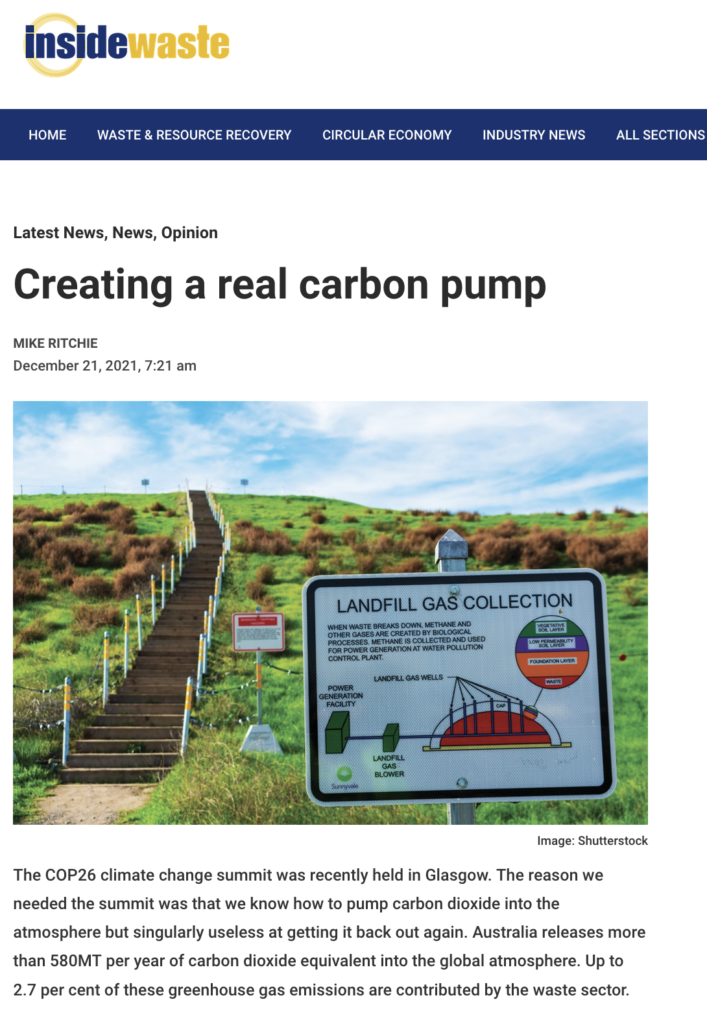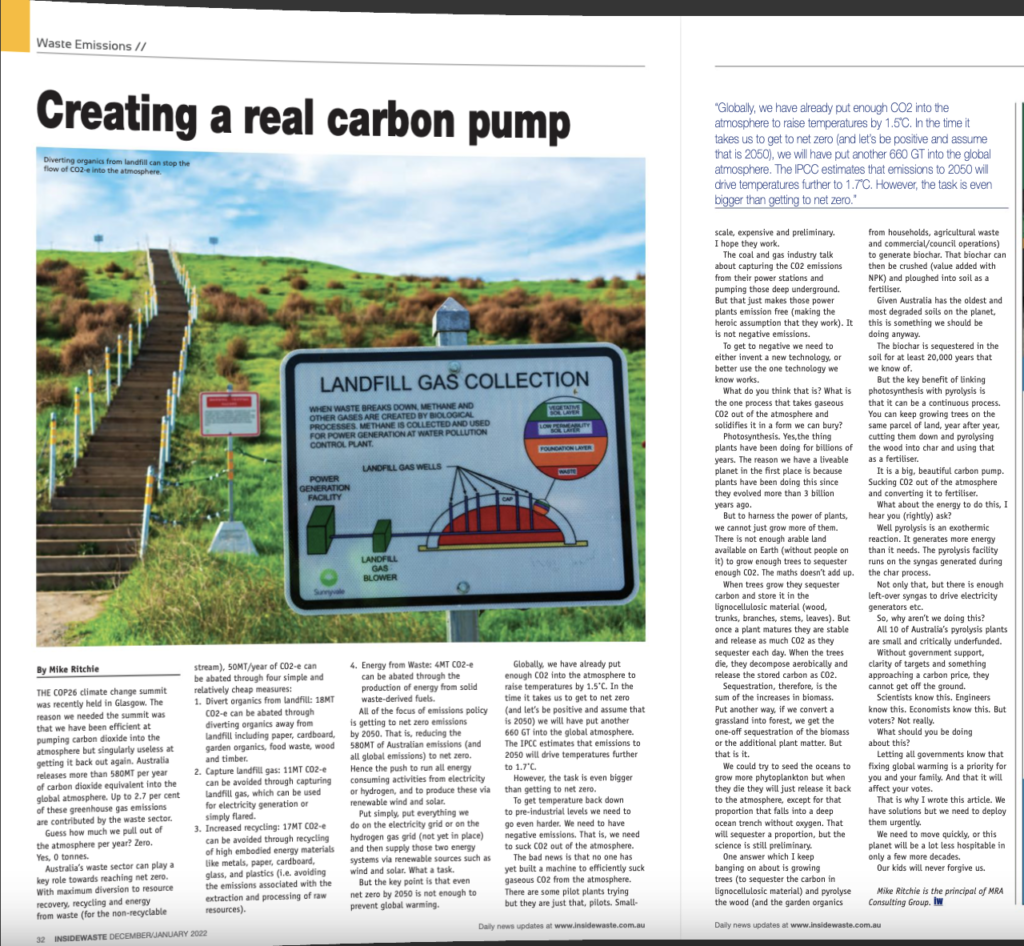Creating a real carbon pump
By: Mike Ritchie, MRA Consulting Group
Australia releases over 580MT per year of carbon dioxide equivalent into the global atmosphere. 2.7% of these greenhouse gas emissions are contributed by the waste sector.
Guess how much we pull out of the atmosphere per year? Zero. Yes, 0 tonnes.
All of the focus of emissions policy is getting to net zero emissions by 2050. That is, reducing the 580MT of Australian emissions (and all global emissions) to net zero. Hence the push to run all energy consuming activities from electricity or hydrogen, and to produce these via renewable wind and solar.
Put simply, put everything we do on the electricity grid or on the hydrogen gas grid (not yet in place) and then supply those two energy systems via renewable sources such as wind and solar. What a task.
But the key point is that even net zero by 2050 is not enough to prevent global warming.
Globally, we have already put enough CO2 into the atmosphere to raise temperatures by 1.5 degrees C. In the time it takes us to get to net zero (and let’s be positive and assume that is 2050) we will have put another 660 GT into the global atmosphere. The IPCC estimates that emissions to 2050 will drive temperatures further to 1.7 degrees C.

Figure: IPCC 2021 data showing future annual emissions of CO₂ (left) and global surface temperature change relative to 1850-1900 (right) across five illustrative scenarios

Australia’s waste sector can play a key role towards reaching net zero. With maximum diversion to resource recovery, recycling and energy from waste (for the non-recyclable stream) 50MT/yr of CO2-e can be abated through four simple and relatively cheaps measures:
- Divert organics from landfill –18MT CO2-e can be abated through diverting organics away from landfill including paper, cardboard, garden organics, food waste, wood and timber.
- Capture landfill gas – 11MT CO2-e can be avoided through capturing landfill gas, which can be used for electricity generation or simply flared.
- Increased recycling – 17MT CO2-e can be avoided through recycling of high embodied energy materials like metals, paper, cardboard, glass, and plastics (i.e. avoiding the emissions associated with the extraction and processing of raw resources).
- Energy from Waste – 4MT CO2-e can be abated through the production of energy from solid waste derived fuels.
However, the task is even bigger than getting to net zero.
To get temperature back down to pre-industrial levels we need to go even harder. We need to have negative emissions. That is, we need to suck CO2 out of the atmosphere.
The bad news is that no-one has yet built a machine to efficiently suck gaseous CO2 from the atmosphere. There are some pilot plants trying but they are just that, pilots. Small scale, expensive and preliminary. I hope they work.
The coal and gas industry talk about capturing the CO2 emissions from their power stations and pumping those deep underground. But that just makes those power plants emission free (making the heroic assumption that they work). It is not negative emissions.
To get to negative we need to either invent a new technology or better use the one technology we know works.
What do you think that is?
What is the one process that takes gaseous CO2 out of the atmosphere and solidifies it in a form we can bury?
Yes. Photosynthesis. The thing plants have been doing for billions of years.
The reason we have a liveable planet in the first place is because plants have been doing this since they evolved over 3 billion years ago.
But to harness the power of plants, we cannot just grow more of them. There is not enough arable land available on earth (without people on it) to grow enough trees to sequester enough CO2. The maths doesn’t add up.
When trees grow they sequester carbon and store it in the lignocellulosic material (wood, trunks, branches, stems, leaves). But once a plant matures they are stable and release as much CO2 as they sequester each day. (When the trees die, they decompose aerobically and release the stored carbon as CO2.)
Sequestration, therefore, is the sum of the increases in biomass. Put another way, if we convert a grassland into forest, we get the one-off sequestration of the biomass or the additional plant matter. But that is it.
We could try to seed the oceans to grow more phytoplankton but when they die they will just release it back to the atmosphere (except for that proportion that falls into a deep ocean trench without oxygen. That will sequester a proportion, but the science is still preliminary).
One answer which I keep banging on about is growing trees (to sequester the carbon in lignocellulosic material) and pyrolyse the wood (and the garden organics from households, agricultural waste and commercial/council operations) to generate biochar. That biochar can then be crushed (value added with NPK) and ploughed into soil as a fertiliser.
Given Australia has the oldest and most degraded soils on the planet, this is something we should be doing anyway.
The biochar is sequestered in the soil for at least 20,000 years (that we know of).
But the key benefit of linking photosynthesis with pyrolysis is that it can be a continuous process. You can keep growing trees on the same parcel of land, year after year, cutting them down and pyrolyzing the wood into char and using that as a fertiliser.
It is a big, beautiful carbon pump. Sucking CO2 out of the atmosphere and converting it to fertiliser.
What about the energy to do this, I hear you (rightly) ask?
Well pyrolysis is an exothermic reaction. It generates more energy than it needs. The pyrolysis facility runs on the syngas generated during the char process.
Not only that, but there is enough left-over syngas to drive electricity generators etc.
So, why aren’t we doing this?
All 10 of Australia’s pyrolysis plants are small and critically underfunded.
Without government support, clarity of targets and something approaching a carbon price, they cannot get off the ground.
Scientists know this. Engineers know this. Economists know this. But voters? Not really.
What should you be doing about this?
Letting all governments know that fixing global warming is a priority for you and your family. And that it will affect your votes.
That is why I wrote this article. We have solutions but we need to deploy them urgently.
We need to move quickly, or this planet will be a lot less hospitable in only a few more decades.
Our kids will never forgive us.
Mike Ritchie, is the Managing Director at MRA Consulting Group.
This article has been published by the following media outlets:





